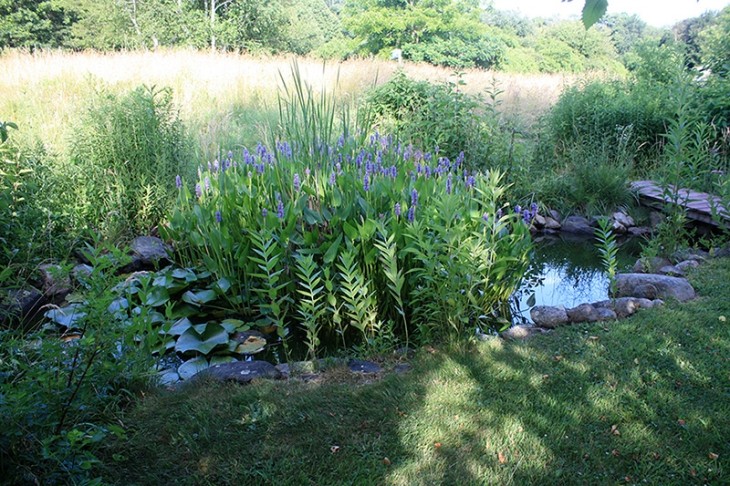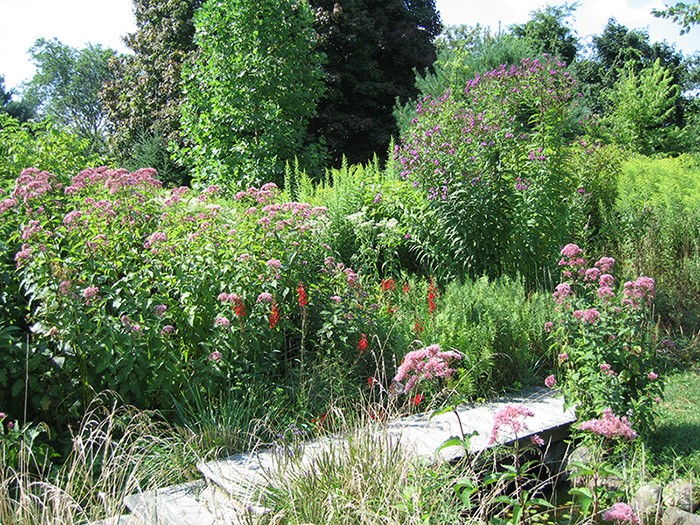
In 1984, I bought a two-acre house lot that had been part of a hayfield on a historical farm in Tiverton, Rhode Island. It was located on the narrow coastal plain of Rhode Island’s East Bay, where members of the Pocasset Tribe once summered, grew vegetables, and burned off tracts of grassland in the autumn. Following King Philip’s War, a slave trader took the land and established one of the original Rhode Island “Providence plantations.” After generations of farming, the property was being subdivided into residential lots.
I built my house on one of the lots with little thought to landscaping, other than ruling out a giant lawn. The back acre of the property had a fieldstone wall along one side, so I kept that area in meadow to connect with the farm’s history. That patch of grass also recalled my early years growing up in a prairie state watching meadowlarks coast across flat horizons of little bluestem. I envisioned a New England version: wind-rippled waves of bluegrass and timothy, commingling with the soft purple “Yorkshire fog” of velvet grass. And a meadow would be easy to maintain, I thought, requiring only an annual pass-through with a brush hog.
Within a couple of years, I’d learned what any seasoned New England land steward knows: maintaining grassland is not easy. New England’s prevalent biome is forest, so natural grasslands only occur where trees cannot grow, or where farming or management prescriptions keep the land cleared. If that management ends, the land will go back to trees in a slow-motion reset called natural succession.
Henry David Thoreau methodically studied the phenomenon of forest succession in central Massachusetts, observing patterns of regrowth on abandoned fresh meadows and cutover woodlots and recording findings in his voluminous journals. It wasn’t long before I noticed some of the changes Thoreau had documented in my own meadow. Broadleaf plants began infiltrating the grass cover, including milkweed, St. John’s wort, Joe Pye weed, and squadrons of goldenrod and asters brightening up the late summer field. Woody vegetation encroached next: shrub sprouts of arrowwood, elderberry, and sumac. Pioneer trees soon joined the parade, with seedlings of old field cedar, gray birch, and black cherry taking root.

The early years of this chaos were fascinating. I even kept a journal with field sketches and a scorecard of new species, including some head-scratchers. For instance, where did ragged fringed orchids and one-flowered broomrape come from? Eventually, the expanding populations of woodies, scratchy brambles, and aggressive invasive plants created maintenance issues, and a rethink of the meadow plan. My little grassland had become what conservation biologists call an old field. Given time, the back acre would evolve into a shrubby thicket, then ultimately a forest. Could there be a forest in my lifetime?
That idea of eventually having a small but ecologically functioning forest on what once was a hayfield gradually possessed me, so I decided to accelerate the natural process with plantings to create a back-acre version of a northeastern temperate forest.
The shrub phase needed little help because natural seeding was well underway, especially the arrowwoods. I actually had to thin them back to what still could have been $5,000 worth of nursery stock! And what wonderful freebies they are, with lovely white floral umbels, fall color, and abundant inky berries that birds gobble up. I added other common native shrubs: sweet pepperbush propagated by a friend, nannyberry rescued from a road easement, witch hazel from a nursery, and spicebush found at a wetland restoration supplier.
Finding native trees for the back acre was more challenging, as some of the most common species were not at all common in the nursery trade. European beech was stocked everywhere, but nobody had American beech. There were lots of canoe birches available, but asking for black birch drew blank expressions. And it took years to find those beauties of the forest middle layer, the two ironwood species.

Several other trees came from friends. I will be forever grateful to the student in a forest class I taught who dug up a basswood sprout for me, and another who gave me license to take sassafras from her woodland. I must confess to adding a few specimen trees that are not so common to southern New England, including black ash, Atlantic white cedar, and a tamarack, which turns a gorgeous golden color in autumn. I’m quite proud of a seed-propagated butternut sapling from a local stand that has, so far, escaped the canker. Thankfully, the Native Plant Trust and other plant conservation nonprofits now stock a broader selection of local provenance trees.
The old phrase that one only plants a tree for grandkids says more about human impatience than dendrology. My root-established saplings have averaged 2 to 3 feet of annual growth. A fleet-stemmed silver maple produced a respectable crown in 12 years, and a bitternut hickory volunteer seemed to grow weary of being deer-browsed one spring and bolted upward 7 feet. The all-time speed champion is an eastern sycamore; planted as a 2½-foot potted sapling, it tripled in height the first growing season, then doubled that the next spring to 15 feet.
Twenty years after I started planting trees, a forest-like, multilayered overstory was growing on the back acre. But a collection of trees is just an arboretum without a complex plant community in the understory. Creating that has been challenging. Canada mayflower, trout lily, and enchanter’s nightshade appeared naturally, mosses crept in on their own cat feet, and planting woodland ferns was fairly straightforward. Some common denizens of the forest floor, however, such as teaberry and pipsissewa, have been difficult to establish. I suspect the problem is in the soil; hundreds of years in meadow grasses may have eradicated the complex microbial life needed for some woodland species.
There also have been unexpected successes. Lovely understory bloomers from Appalachia, such as Virginia bluebells, bright yellow celandine poppy, and wonderful trilliums seem surprisingly at home. While those species violate my original eco-compact to use only local, common species, perhaps surrendering to one gardening impulse could be forgiven.
Early in the maturation of the back-acre woods, another nascent microhabitat emerged. At the woodland edge was a low area that often had standing water, which suggested a promising pond site. A half day’s backhoe work and some creative underground PVC piping from roof downspouts produced a small pond, which is now shaded by an alder thicket. The pond overflows into an area surrounded by a low berm that I put in to create hydric soil for wetland plants.
Green frogs took up residence the very first spring, harbingers of the amazing biodiversity that followed. This wetland also may have saved a clan of noisy spring peepers that was forced to abandon its peeping grounds on an adjacent lot. When site preparation for a house began, the peepers moved next door into my woods. The pond and wetland microhabitat are small, but they have attracted a multitude of wildlife. Along with the noisy amphibians and a wealth of aquatic invertebrates, it’s a nocturnal gathering place for mink, racoon, and weasels. A mallard pair even eyed it for nesting one spring.
Creating nature is, by definition, an oxymoronic concept. Partnering with nature, however, by nurturing conditions that connect with natural surroundings, and by using natural landscape processes can result in real backyard biodiversity, as well as aesthetic beauty. This might require suppressing some conventional gardening urges: absolute control, orderly design, and “unique” plants. It also helps to develop an appreciation for beauty in the commonplace and a tolerance for disorder. All that “coarse woody debris” can look just fine gathered into a wildlife covert in some discreet woodland alcove.
The street view of my house reveals nothing unconventional. Out in the back acre, however, is a little woodland that I’m drawn to every day. The path to it goes through patches of the original meadow and old field, so walking to my woods is a stroll through successional time. John Burroughs wrote, “To learn something new, take the path that you took yesterday.” Watching that original meadow transform over the years into an increasingly complex web of life has drawn me down countless yesterday paths, where I’m always learning, where every tree has a story, and where discoveries of nature continue to surprise.

